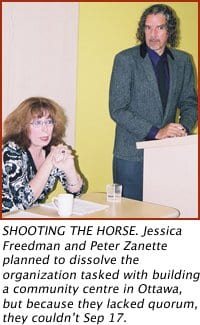Poor turnout at the annual general meeting for Ottawa’s gay community centre project meant that board members could not even dissolve the corporation.
The meeting held at the Centretown Community Health Centre on Sep 17 drew only seven members, making up less than half of the quorum of 20 required to vote on any motions. The three board members present — of nine seats — used the meeting as an opportunity to inform those in attendance of the challenges faced by the fledgling organization in its first year as a corporation.
“It’s one thing to run a community centre, it’s another to build up to it and get people with the those skill sets required and bring them on board,” says interim-chair Peter Zanette. “I have to learn to ask for help more. It’s one of my weaknesses as a chair, but we ain’t over yet. We’ll walk slower and go a different path.”
The board tasked with bringing a queer community centre to Ottawa has spun its wheels over the last month after failing to attract top talent at their 2006 AGM. A 2002 feasibility study is the closest any organization has come to realizing the dream of a queer community space since Gays Of Ottawa shut its doors in 1995.
Although the turnout made the topic a moot point, the proposed motion for dissolution led to a lengthy discussion. Former chair and continuing board member James Bromilow referred to the unofficial motion as “drawing a line in the sand.”
The motion, had it been possible to vote on, was read by board member and chair of the meeting Jessica Freedman.
“We the membership hereby dissolve the GLBTTQ Community Centre of Ottawa Inc, and authorize the remaining board of trustees to contract member dissolution services and oversee the dissolution of the GLBTTQ Community Centre of Ottawa Inc, and to disperse its remaining assets to Pink Triangle Services.”
Bromilow spoke about the limbo the corporation has been placed in due to the lack of interest of community members.
“We have 60 members of the organization — official members — who have the right to vote and get information from the board of directors, to elect the board of directors, and tonight we have 13 people short of quorum, which is only seven people, so we can’t even dissolve the corporation,” he says.
“The board doesn’t even have the authority to manage the affairs. We can’t write cheques without the authority of the membership to do that. So the motion to dissolve the corporation was to sort of draw a line in the sand, so to speak. To say, either you want a community centre or you don’t want a community centre, but you have to make a decision one way or the other. And tonight I suppose the public has said they don’t care enough to show up.”
The project’s leadership repeated cited the rainbow village project as undermining their work. The Rainbow Village Community And Business Association has met only once, in April, with the primary purpose of setting up lines of communication through e-mail.
“The secret formation of the Bank Street Rainbow Committee made us question our purpose. We should have been included. Our organization included a strategic planning committee that would have met the needs as well as being openly accountable to the community,” says Zanette in his report at the AGM.
Representatives of the queer community centre project attended the April meeting and signed up for the village listserv. The village’s ad hoc meeting was planned with the backing of Capital Xtra, PTS, Bruce House, AIDS Committee Of Ottawa and Capital Pride.
With the board unable to move forward with authority, and the apparent lack of interest on the part of the community it hopes to serve, the future is hazy for Ottawa’s community centre. Zanette outlined what will be required in order to ensure the success of the project. Each item highlights the difficulties the board has encountered throughout the past year.
“What is needed is board members whose primary volunteer priority is the community centre project; a consistent communication strategy that explicitly promotes the [queer] aspect of our project; a business plan that would be a basis for fundraising at all levels both inside and outside our community. It is as simple as planning the work and working the plan. It is not simple in the details.”

 Why you can trust Xtra
Why you can trust Xtra


